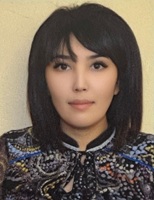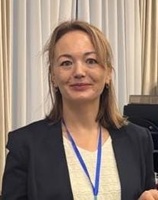Ethnocultural images of everyday life in the prose of modern Eurasian writers
DOI:
https://doi.org/10.25178/nit.2025.2.13Keywords:
Eurasian; mythology of everyday life; artifact; ethnocultural image; national image; transculturation; ritual and ceremonial life; circumcision; bazaar; museumAbstract
The article analyzes ethnocultural imagery in the prose of contemporary writers who came of age in the Central Asian republics (Kyrgyzstan, Uzbekistan, Kazakhstan) at the turn of the 20th and 21st centuries. It substantiates the appropriateness of using the terms “Eurasian” and/or “Russophone” in reference to writers previously categorized by scholars as “Russian-language”— a designation that referred to bilingual authors who chose Russian as the language of their creative work, while not being ethnically Russian. The synthesis of the Russian linguistic system with a non-Russian system of imagery has given rise to a distinct literary tradition that cannot be unequivocally identified either with Russian literature or with any other national literature. This body of work constitutes a unique stratum of literature created by individuals possessing a non-singular, polychromatic worldview and, frequently, a hybrid or multiple ethnic identity.
The primary materials for this study are works written in Russian by Sukhbat Aflatuni, Vadim Muratkhanov, Sandzhar Yanashev, Shevket Keshfidinov, Alexander Grishchenko, and Ilya Odegov, whose prose, while rendered in Russian, conveys a non-Russian system of imagery.
It is demonstrated that, unlike the preceding generation of Soviet authors —ethnically non-Russian but writing in Russian — the prose of these contemporary writers is marked by an introverted poetics of imagery. Their heightened sense of self-identification and self-reflection is shown to be conditioned by the socio-political transformations associated with the dissolution of the USSR and the accompanying existential demands. The analysis focuses on ethnocultural images of everyday life: ritual practices (circumcision), elements of so-called sympathetic magic, belief in metamorphism (transformation), artifacts imbued with metaphysical significance (protective talismans, amulets), and spaces such as the bazaar and the museum, as well as a gastronomic artifact — the flatbread. The study notes convergences in anthropological tendencies and existential concerns as reflected in the artistic imagery of the selected authors. It reveals that the poetics of ethnocultural imagery in their works expresses a mythology of everyday life, endowed with existential functions — without the comprehension and representation of which the formation of a new historical memory becomes impossible.
References
Abdullaev, E. (2006) Contemporary Russian literature of Central Asia: a case of multilayered reflection, Voprosy literatury, no. 3, pp. 320–326. (In Russ.)
Anninsky, L. A. (2001) Russians plus... Moscow, Algoritm. 384 p. (In Russ.)
Arzamazov, A. A. (2021) Between 'one's own' and 'the alien': linguistic and artistic realities, problems and prospects of the literature of the peoples of the Far North and the Far East. Filologicheskie nauki Nauchnye doklady vysshei shkoly, no. 6–2, pp. 246–255. (In Russ.)
Bakhtikireeva, U. M. (2009) The creative bilingual personality (features of the Russian text of a Turkic author). Astana, TsBOiMI. 259 p. (In Russ.)
Bakhtikireeva, U. M. (2021) Russophone — Russophonic — Russophonia — Russophonic literature: global or local words? Sotsialnye i gumanitarnye nauki na Dalnem Vostoke, vol. 18, no. 1, pp. 11–17. (In Russ.)
Bakhtikireeva, U. M. (2024) Georgy Gachev and his method of thinking: changing the person and the world. New Research of Tuva, no. 4, pp. 6–19. (In Russ.) DOI: https://doi.org/10.25178/nit.2024.4.1
Bakhtikireeva, U. M. and Valikova, O. A. (2017) The origins of translanguaging Russian-language literature. Sotsialnye i gumanitarnye nauki na Dalnem Vostoke, vol. 14, no. 1, pp. 18–23. (In Russ.)
Bakhtikireeva, U. M. and Valikova, O. A. (2022) ‘Language keys’: foreign vocabulary in the translanguaging (Russophone) literary text. Vestnik Rossiiskogo universiteta druzhby narodov Seriya Teoriya yazyka Semiotika Semantika, vol. 13, no. 1, pp. 184–200. (In Russ.)
Bakhtikireeva, U. M., Valikova, O. A. and Tokareva, N. A. (2021) On the ‘Agora’ today: approaches to the study of translanguaging literature. Filologicheskie nauki Nauchnye doklady vysshei shkoly, no. 6–2, pp. 263–273. (In Russ.)
Garipova, G. T. (2024) The image of the thinking world ‘beyond the brain’ in the novel Southern Mangazeya by Kior Yanov. Palimpsest Literaturovedcheskii zhurnal, no. 1(21), pp. 50–70. (In Russ.)
Gachev, G. D. (1987) National images of the world. Voprosy literatury, no. 10, pp. 156–191. (In Russ.)
Gachev, G. D. (2002) National images of the world Caucasus Intellectual journeys from Russia to Georgia, Azerbaijan and Armenia. Moscow, Izdatelskii servis. 416 p. (In Russ.)
Gachev, G. D. (2008) Mentalities of the peoples of the world. Moscow, Algoritm Eksmo. 544 p. (In Russ.)
Eleukenov, Sh. R. (2013) The Eurasian talisman On the literary origins of the movement. In: Kalizhanov U. K. (ed.) Classical studies: Collected volumes Eurasianism and dialogue of cultures. Vol. 19. Almaty, Adebiet Alemi. 396 p. Pp. 255–290. (In Russ.)
Casanova, P. (2003) The world republic of letters, trans. by M. Kozhevnikova and M. Letarova-Gister. Moscow, Izdatelstvo im. Sabashnikovykh. 416 p. (In Russ.)
Kolmogorova, T. N. (2015) Ethnocultural distinctiveness of the worldview: on the stories by S. Aflatuni, V. Muratkhanov, I. Odegov, A. Tork, S. Yanyshev. Voprosy literatury, no. 1, pp. 260–283. (In Russ.)
Nalimov, V. V. and Drogalina, Zh. A. (1984) A probabilistic model of the unconscious. The unconscious as a manifestation of the semantic universe, Psikhologicheskii zhurnal, vol. 5, no. 6, pp. 111–122. (In Russ.)
Tokareva, N. A. (2024) Ethnic and linguistic self-identification of Namzhil Nimbuev in poetic discourse. Polilingvialnost i transkulturnye praktiki, vol. 21, no. 2, pp. 260–279. (In Russ.)
Frazer, J. G. (2001) The golden bough A study in magic and religion: in 2 vols. Trans. by M. Rykhlin. Moscow, TERRA — Knizhnyi klub. Vol. 1. 528 p. (In Russ.)
Khukhuni, G. T. and Valuytseva, I. I. (2021) Bilingual creativity: code-switching or language shift? Filologicheskie nauki Nauchnye doklady vysshei shkoly, no. 6–2, pp. 227–233. (In Russ.)
Shafranskaia, E. F. (2023) Post-Soviet themes in contemporary Russian transcultural literature: the novel Hands-Rivers by Liana Shakhverdyan. In: Zhigalova, M. P. (ed.) Ethnicities and destinies in the modern society Theory and practice. Brest, BrGTU. 224 p. Pp. 54–61. (In Russ.)
Shafranskaia, E. F. and Garipova, G. T. (2024) The prose of Timur Pulatov Ethnocultural discourse. St. Petersburg, Svoe izdatelstvo. 300 p. (In Russ.)
Etkind, A. M. (2016) Warped mourning Memory of the unburied. Moscow, Novoe literaturnoe obozrenie. 328 p. (In Russ.)
Published
How to Cite
For citation:
Bekmuratova A. E. and Khudaiberdina D. A. Ethnocultural images of everyday life in the prose of modern Eurasian writers. New Research of Tuva, 2025, no. 2, pp. 231-245. (In Russ.). DOI: https://doi.org/10.25178/nit.2025.2.13
Issue
Section

This work is licensed under a Creative Commons Attribution-NonCommercial 4.0 International License.

Author(s) license holder(s) grant rights for their work to the journal (grantee of a license) under the simple non-exclusive open license in accordance with Art. 1286.1 «Open license for a research work, work of literature or fine arts», Civil Code of the Russian Federation.
New Research of Tuva publishes articles under the Creative Commons Attribution-NonCommercial license (CC BY-NC).
Since it is an open license, author(s) reserve the right to upload the article to their institutional repository, submit it to another journal (if it allows republications), or republish it on their own website (in full, or in part).
However, several conditions apply here:
a) The republished version must always contain the name(s) and affiliation(s) of the author(s), the original title and the hyperlink to the original version on the New Research of Tuva website;
b) It must be in open access, free of charge, and no category of readers must be in any way whatsoever advantaged over general readership.
c) should the contribution be submitted elsewhere by its author(s) without substantial modification (30% or more of original text unchanged), the body of the article should contain a disclaimer that the original version was published in New Research of Tuva (with a link to the respective page)
The CC-BY-NC is a non-revocable license which applies worldwide and lasts for the duration of the work’s copyright.










